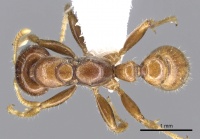Pseudomyrmex insuavis
| Pseudomyrmex insuavis | |
|---|---|

| |
| Scientific classification | |
| Kingdom: | Animalia |
| Phylum: | Arthropoda |
| Class: | Insecta |
| Order: | Hymenoptera |
| Family: | Formicidae |
| Subfamily: | Pseudomyrmecinae |
| Genus: | Pseudomyrmex |
| Species: | P. insuavis |
| Binomial name | |
| Pseudomyrmex insuavis Ward, 1999 | |
Known only from a few collections.
Identification
Ward (1999) - The posterolaterally expanded petiole (worker PWI > 0.91, queen PWI ≈ 0.79) distinguishes P. insuavis from its close relatives Pseudomyrmex concolor and Pseudomyrmex penetrator (worker PWI < 0.91, queen PWI < 0.74). A broad petiole is also seen in some workers of Pseudomyrmex malignus but P. insuavis differs from that species by the conspicuous erect hairs on the sides and posterior margin of the head, by the more abundant pilosity on the mesosoma and legs (compare MSC and HTC values), by the less well separated antennal insertions, and by the shape of the median clypeal lobe (ventrally deflected and laterally rounded in P. insuavis).
Distribution
Latitudinal Distribution Pattern
Latitudinal Range: -0.633333333° to -3.5242°.
| North Temperate |
North Subtropical |
Tropical | South Subtropical |
South Temperate |
- Source: AntMaps
Distribution based on Regional Taxon Lists
Neotropical Region: Colombia (type locality).
Distribution based on AntMaps
Distribution based on AntWeb specimens
Check data from AntWeb
Countries Occupied
| Number of countries occupied by this species based on AntWiki Regional Taxon Lists. In general, fewer countries occupied indicates a narrower range, while more countries indicates a more widespread species. |

|
Estimated Abundance
| Relative abundance based on number of AntMaps records per species (this species within the purple bar). Fewer records (to the left) indicates a less abundant/encountered species while more records (to the right) indicates more abundant/encountered species. |

|
Biology
Ward (1999) - P. insuavis is known only from a few localities in the western Amazon basin. Greg Gangi’s collections came from plants identified as Tachigali cf. formicarum Harms, Tachigali hypoleuca (Bentham) Zarucchi & Herendeen, Tachigali paniculata and Tachigali cf. poeppigiana.
Castes
Nomenclature
The following information is derived from Barry Bolton's Online Catalogue of the Ants of the World.
- insuavis. Pseudomyrmex insuavis Ward, 1999b: 492, figs. 10, 21, 32, 136, 152 (w.q.) COLOMBIA.
Unless otherwise noted the text for the remainder of this section is reported from the publication that includes the original description.
Description
Worker
Measurements (n=11). HL 1.01–1.14, HW 0.94–1.06, MFC 0.101–0.128, LHT 0.73–0.86, CI 0.89–0.94, REL 0.36–0.39, REL2 0.38–0.41, FCI 0.11–0.13, SI 0.41–0.43, FLI 1.04–1.38, FI 0.38–0.41, PLI 0.91–1.00, PWI 0.92–1.04, PPWI 1.53–1.69.
Very similar to Pseudomyrmex concolor, except as follows. Petiole shorter, and broader posteriorly; PWI > 0.91 (< 0.91 in P. concolor); PWI3 0.44–0.51 (0.51–0.59 in P. concolor); PLI2 0.87–0.99 (0.79–0.93 in P. concolor). As in P. concolor, standing pilosity is conspicuous on the head, mesosoma, petiole, postpetiole, gaster and legs (MSC 31–66, HTC 8–15). Appressed pubescence on abdominal tergite IV variable, the hairs separated by more than their lengths in some workers, and the area correspondingly more shiny. Body colour much more variable than in P. concolor, ranging from concolorous yellow- or orange-brown to dark brown; also intermediate bicoloured conditions with the head and/or (mesosoma + petiole + postpetiole) and/or abdominal segment IV (first gastric segment) lighter in color than the remainder of the body (such variation can be seen within single nest series).
Type Material
Holotype worker. COLOMBIA, Amazonas: Araracuara [0°38’S, 72°15’W] .iv. 1994, G. Gangi#223, ex Tachigali cf. poeppigiana (Museo de Historia Natural). HW 1.00, HL 1.08, EL 0.39, LHT 0.79, PL 0.46, PH 0.46.
Paratypes. Same locality as holotype, iii–ix. 1994, G. Gangi acc. nos. 11, 20, 177, 185, 223, 224, 269, and 439: Series of workers, 1 queen (to be deposited in BMNH, FFIC, Instituto Nacional de Pesquisas da Amazonia, Instituto de Zoologia Agricola, Los Angeles County Museum of Natural History, Museum of Comparative Zoology, MECN, Museu Paraense Emilio Goeldi, Museo de Historia Natural, Museu de Zoologia da Universidade de Sao Paulo, Philip S. Ward Collection, Museo de Zoologia, University of California, Davis, UCNB.
References
- Ward, P. S. 1999b. Systematics, biogeography and host plant associations of the Pseudomyrmex viduus group (Hymenoptera: Formicidae), Triplaris- and Tachigali-inhabiting ants. Zool. J. Linn. Soc. 126: 451-540 (page 492, figs. 10, 21, 32, 136, 152 worker, queen described)

